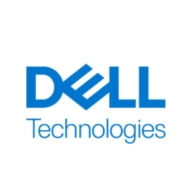


Dell PowerMax and Dell PowerStore are key players in the data storage solution category. PowerMax holds the upper hand due to its superior performance in high-demand environments, while PowerStore excels in ease of use and integration capabilities.
Features: Dell PowerMax offers NVMe-based architecture, solid latency improvements, and effective data reduction, making it excellent for performance-intensive settings. Dell PowerStore is noted for its ease of use, flexible scalability, and intelligent data management features like embedded deduplication and compression. Its seamless integration with VMware and cloud support is also a standout.
Room for Improvement: Dell PowerMax can enhance its command-line interface, improve its configuration complexity, and expand its reporting capabilities. Dell PowerStore needs to improve its NAS capabilities, enhance replication features, and resolve stability concerns post-upgrades.
Ease of Deployment and Customer Service: Dell PowerMax benefits from high-end technical support which aids efficient troubleshooting. Dell PowerStore is praised for its deployment simplicity and VMware integration, though faces challenges in clustering flexibility. Dell's customer service is generally reliable for both, with variations based on regional support.
Pricing and ROI: Dell PowerMax often has a higher price, justified by its advanced performance capabilities for enterprise-level solutions. However, it offers ROI through latency reduction and energy efficiency. Dell PowerStore offers competitive pricing relative to its features, with cost savings enabled through efficient storage management, making it more attractive for mid-sized businesses.
If you wait more than seven years to buy another one, you get a return on your investment.
During a DCDR setup and migration from VMAX to Dell PowerMax, what was planned as a two-day downtime was completed in just three to four hours.
The performance metrics or benchmarks I use to measure success with Dell PowerMax include uptime as well as our response times on our platforms, both of which are exactly where we want them to be, which is five nines and as fast as possible.
My client has seen significant ROI since the install, and when you don't go down, that's an ROI in and of itself.
If you purchase storage with 300 terabytes, you can easily achieve one petabyte of effective capacity.
It's been trouble-free the entire time, with very high performance, as it has been designed and built properly.
We have seen a return on our investment in Dell PowerStore; definitely our cost per terabyte has been very good compared to some of the other vendors that we would have been using previously, and our performance benchmarks have exceeded what we were expecting.
Customers always have their issues resolved promptly.
Technical support is good at least through vendors, not directly with the principal.
I would rate Dell PowerMax support as a ten, as I have never had an issue with Dell support as it relates to this product.
ProSupport Next Business Day offers part replacement within four hours for data leaks.
Dell support for Dell PowerMax is exceptional, rating a perfect 10 out of 10.
I would rate the technical support of Dell PowerStore between nine and ten out of ten.
They're responsive, knowledgeable, and have a quick turnaround.
On a scale of one to ten, I would rate Dell support as a ten, focusing on that aspect alone, because it's what allows me to sleep at night.
It hasn't broken down anytime in the last six to seven years, despite hurricanes, earthquakes, and power outages.
Scalability is not an issue.
Dell PowerMax is good for enterprises, and it also depends on how much workload you're going to bring in on Dell PowerMax in terms of performance and how many users are going to use the database you're hosting.
PowerScale is better suited for AI and overall buzz solution currently.
The solution's scalability is a ten out of ten.
It scales up and scales out both ways, and as our data keeps growing, it is very easy to just keep attaching and keep growing.
Scaling up can be done from a single enclosure that already has two controllers to a maximum of four storage units with up to eight controllers, and a massive amount of storage can be added.
I would rate the stability of the product at seven out of ten.
These patches can be applied on the fly without requiring software upgrades or system downtime.
I would rate it nine out of ten since there are no required downtimes, even during firmware upgrades.
There has been no downtime with Dell PowerMax; it's been extremely reliable, easy to manage, easy to upgrade, and trustworthy as we've upgraded over the years from one version to another.
When I removed all the cables, it failed over within five minutes.
It's quite stable and reliable in general.
There are no bugs or glitches and it doesn't crash or freeze.
One way to improve the product is to add an operational assistant that doesn't depend on VMware.
I would like to see some AI features that would allow arrays to intelligently identify threats or unusual behavior in the data pattern and give an alert.
Storage replication should be essential.
Compared to competitors such as NetApp, which integrates with public cloud hyperscalers (GCP, Azure, AWS), Dell PowerMax lacks in this aspect.
Dell can assist by providing plug-and-play integrated templates that allow customers to drag, drop, modify, and connect with any target system for generating snapshots without logging into the storage directly.
Dell PowerMax NVMe is very reliable storage and cannot experience downtime.
Something needs to be done with the caching to ensure that if some issue occurs, there needs to be an ability to disable caching during maintenance to make it static, safe, and good.
Pricing must also be considered, as Dell PowerStore is quite expensive compared to competitors in the market like HPE Alletra, Huawei Dorado, or Hitachi storage, for example.
The main reason why people move to Pure Storage is because it's simplified.
While the prices may be higher than those of other vendors, we see it as a market leader with benefits.
The support can be a bit pricey, but the solution is more cost-effective than anything else out there.
The higher cost compared to other vendors is justified by additional features, vendor-managed upgrades, and superior support services.
It is the best choice for large projects in terms of price and features compared to midrange solutions.
The price is starting from $500,000.
Likely the cost is $400,000 whereas IBM may be $250,000.
Based on my experience, the cost of Dell PowerStore for around 500 GB of capacity is very competitive compared to any other platform in the market.
I asked for a new quotation on a server, and it is quite expensive; it is really expensive.
Its data compression feature is the best that we have ever seen.
Pure FlashArray X NVMe helps to improve our processing speed.
We are satisfied with the performance as it is significantly faster compared to traditional storage options.
NVMe provides additional fast cache, similar to random access memory (RAM), which improves overall system performance and read/write experience for users.
Dell PowerMax NVMe is very supportive of our operational growth since we require daily performance from our core banking systems and need to facilitate data movement efficiently.
The key benefits of using Dell PowerMax, quantified in terms of saved hours and saved costs, is having one single platform that provides functionality to all of our internal customers.
This includes storage sharing, adding servers to the service, and the wireless host connection on the network side.
Dell PowerStore offers good integration capabilities, especially since it helps with backup, which is an important aspect.
In terms of whether my company could reduce the power consumption with Dell PowerStore, I would say that my company had a use case with a customer around three weeks ago where their old Dell EMC VNX Storage System used to draw about 2500 watts compared to Dell PowerStore which drew about 800 watts, which is a really a big saving looking at the twenty-four hours and seven days of usage of the system.
| Product | Market Share (%) |
|---|---|
| Dell PowerStore | 20.2% |
| Dell PowerMax | 9.3% |
| Pure FlashArray X NVMe | 4.0% |
| Other | 66.5% |


| Company Size | Count |
|---|---|
| Small Business | 15 |
| Midsize Enterprise | 11 |
| Large Enterprise | 12 |
| Company Size | Count |
|---|---|
| Small Business | 17 |
| Midsize Enterprise | 15 |
| Large Enterprise | 55 |
| Company Size | Count |
|---|---|
| Small Business | 51 |
| Midsize Enterprise | 34 |
| Large Enterprise | 77 |
Pure Storage FlashArray//X is the world’s first enterprise-class, all-NVMe flash storage array. It represents a new class of storage – shared accelerated storage, which is a term coined by Gartner – that delivers major breakthroughs in performance, simplicity, and consolidation.
PowerMax leads in mission-critical enterprise storage with advanced architecture and AI-driven automation, ensuring secure and efficient IT optimization. Its multi-node NVMe scale-out framework delivers unmatched performance and consolidation, backed by Dell’s Future-Proof Program.
PowerMax is renowned for its robust reliability, performance, and efficient data reduction capabilities. Users benefit from its NVMe architecture, aiding significant scalability and cost efficiency through effective deduplication and compression. Unisphere simplifies management, while CloudIQ provides enhanced monitoring. With high availability and strong IOPS capabilities, PowerMax effectively manages demanding workloads and ensures seamless operations. Its compact design and increased storage capacity enhance user experience, particularly with easy maintenance and robust performance.
What are the key features of PowerMax?Dell PowerMax is predominantly employed in mission-critical applications such as SQL, Oracle databases, ERP systems, and high transactional environments. Healthcare, finance, and e-commerce sectors leverage its high performance, scalability, and NVMe technology for low latency and redundancy. It is adept in storage consolidation, data analytics, and disaster recovery.
Dell PowerStore is a scalable, high-performance platform supporting both modern and traditional workloads, enhancing IT operations with AI-driven automation and advanced data reduction features.
Designed for flexibility, Dell PowerStore integrates seamlessly with VMware, providing robust security and high IOPS. Users benefit from fast NVMe storage, intelligent data management, and scalable performance to handle diverse workload demands. However, improvements are needed in replication, enterprise functionalities, and UI complexity. Stability and support issues highlight the need for enhanced monitoring and pricing strategies.
What are the key features of Dell PowerStore?
What benefits does Dell PowerStore offer?
In industries like finance, healthcare, and IT, Dell PowerStore is critical for VMware virtualization, high-performance databases, and backup storage. It supports hosting virtual machines, mirroring storage, and handling SAP and Oracle databases effectively. Its role in hybrid and on-premises setups showcases its adaptability and integration capabilities for mission-critical tasks.
We monitor all NVMe All-Flash Storage Arrays reviews to prevent fraudulent reviews and keep review quality high. We do not post reviews by company employees or direct competitors. We validate each review for authenticity via cross-reference with LinkedIn, and personal follow-up with the reviewer when necessary.